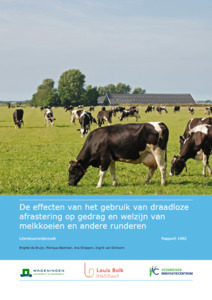{Tool} The effects of using wireless fencing on behavior and well-being of dairy cows and other cattle. [De effecten van het gebruik van draadloze afrastering op gedrag en welzijn van melkkoeien en andere runderen.] Creator(s): De Bruijn, Brigitte; Egas, Youri; Bestman, Monique; Strappini, Ana and van Dixhoorn, Ingrid. Issuing Organisation(s): LBI - Louis Bolk Institute, WUR - Wageningen University & Research. (2024)
![[thumbnail of 2024-12-04 16_25_13-de_effecten_van_het_gebruik_van_draadloze_afraste-wageningen_university_and_rese.png]](/54428/1.hassmallThumbnailVersion/2024-12-04%2016_25_13-de_effecten_van_het_gebruik_van_draadloze_afraste-wageningen_university_and_rese.png)  Preview |
Image (PNG)
- Cover Image
- Dutch/Nederlands
732kB |
Preview |
PDF
- Published Version
- Dutch/Nederlands
2MB |
Document available online at: https://louisbolk.nl/sites/default/files/publication/pdf/de-effecten-van-het-gebruik-van-draadloze-afrastering-op-gedrag-en-welzijn-van-melkkoeien-en-andere.pdf
Summary in the original language of the document
In this report you will learn about how wireless fencing works, about animal welfare in relation to wireless fencing, about different wireless fencing approaches, for example, power collars also used for dogs. In summary, the vast majority of animals were found to be able to cope with the wireless fence within one or a few days and be able to cope and receive hardly any electric shocks after a few days. A small proportion of the animals, however, have more difficulty learning to cope with wireless fencing or take any shocks for granted, based on the number of signals delivered to the animals via the collar. More research is needed to find out what the latter means for animal welfare and whether customization is needed to improve the welfare of these animals. Most of the available research covers a period of a few days or weeks. The question remains, what are the effects on animal welfare when using wireless fencing over a longer period of time, i.e. months or years.
Summary translation
De overgrote meerderheid van de dieren bleek binnen één of enkele dagen met de draadloze afrastering om te kunnen gaan en na enkele dagen nauwelijks elektrische schokken te ontvangen. Een klein deel van de dieren heeft echter meer moeite om met de draadloze afrastering om te leren gaan of neemt eventuele schokken voor lief, gebaseerd op het aantal signalen dat via de halsband aan de dieren wordt afgegeven. Er is meer onderzoek nodig om erachter te komen wat dit laatste betekent voor het dierenwelzijn en of er aanpassingen nodig zijn om het welzijn van deze dieren te verbeteren. Het meeste beschikbare onderzoek bestrijkt een periode van enkele dagen of weken. De vraag blijft wat de effecten op dierenwelzijn zijn bij gebruik van draadloze afrastering over een langere periode, d.w.z. maanden of jaren.
| EPrint Type: | Practice tool |
|---|---|
| Teaser: | Learn about how wireless fences work, what their benefits are and how they perform in releation to animal welfare. |
| What problem does the tool address?: | The aim of this study was to investigate the effects of virtual fencing on the welfare and behaviour of cattle. |
| What solution does the tool offer?: | Wireless, virtual fencing is an alternative and complement to (shock) wire for grazing cattle. The cow is fitted with a collar with a GPS function, which emits sound and electrical signals when an animal threatens to go outside an area designated by the livestock owner. This system provides opportunities for customized livestock grazing in pastures and natural areas, with only all the way around still requires physical fencing. Wireless fencing contributes via positioning and changes therein (or not) contributes to better monitoring of animals and provides flexible pasture management because the fence can easily be moved (digitally). Worldwide several systems are available, but for the Dutch situation, it is still new. Although a lot of research has already been done into the effects on animal welfare and benefits for livestock farmers, there are still questions regarding application possibilities, for example when working towards nitrogen efficiency and biodiversity goals. To this end, the VIPNL project 'Dynamic Wireless Grazing' is investigating these issues. |
| Country: | Netherlands |
| Type of Practice Tool: | Leaflets & guidelines |
| Keywords: | cattle, grazing, fencing, animal welfare, animal protection, animal husbandry equipment, farm management |
| Agrovoc keywords: | Language Value URI English cattle http://aims.fao.org/aos/agrovoc/c_1391 English grazing http://aims.fao.org/aos/agrovoc/c_25243 English animal welfare http://aims.fao.org/aos/agrovoc/c_443 English animal protection http://aims.fao.org/aos/agrovoc/c_37636 English animal husbandry equipment http://aims.fao.org/aos/agrovoc/c_25746 English farm management http://aims.fao.org/aos/agrovoc/c_2799 |
| Subjects: | Animal husbandry > Production systems > Dairy cattle Animal husbandry > Production systems > Beef cattle Animal husbandry > Health and welfare |
| Research affiliation: | Netherlands > Louis Bolk Institute European Union > Horizon Europe > OrganicAdviceNetwork > selected tools European Union > Organic Farm Knowledge Netherlands > Wageningen University & Research (WUR) |
| Horizon Europe or H2020 Grant Agreement Number: | 101134850 |
| Related Links: | https://organic-farmknowledge.org/tool/54428 |
| Project ID: | OFK |
| Deposited By: | Rüger, Madelaine Lea |
| ID Code: | 54428 |
| Deposited On: | 06 Jan 2025 10:00 |
| Last Modified: | 14 Mar 2025 14:40 |
| Document Language: | Dutch/Nederlands |
| Status: | Published |
Repository Staff Only: item control page

 Download Statistics
Download Statistics Download Statistics
Download Statistics
